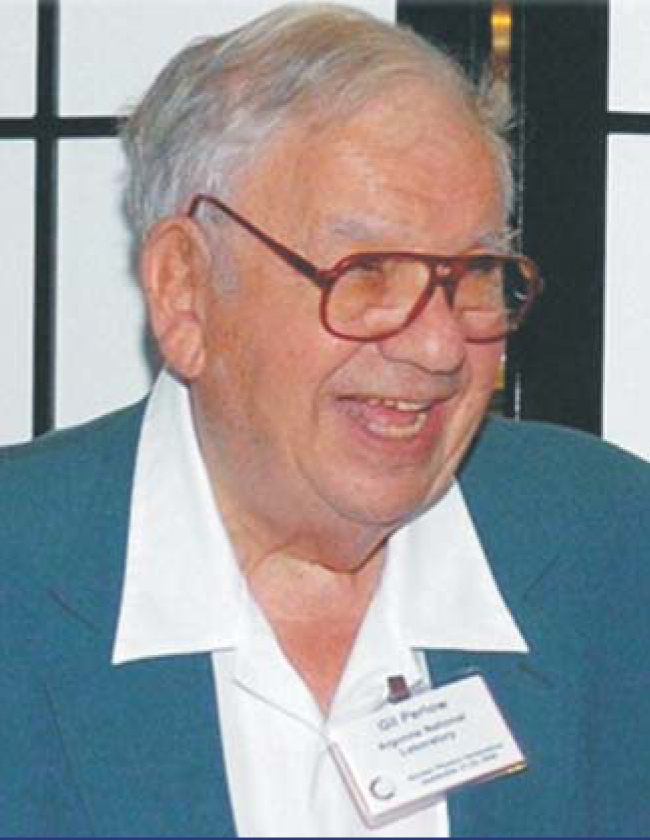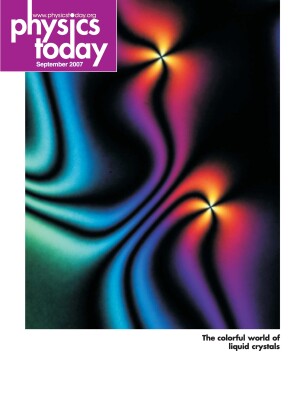Gilbert Jerome Perlow
DOI: 10.1063/1.2784699
Gilbert Jerome Perlow, one of the pioneers of the Mössbauer effect and an editor of the Journal of Applied Physics and Applied Physics Letters, died on 17 February 2007 of heart failure, a week after his 91st birthday.
Born in New York City on 10 February 1916, Gil attended Townsend Harris Hall (now Townsend Harris High School) in Queens. A science teacher realized he had a pupil who could make apparatus run and who had the intellectual curiosity to try to understand how the world works. That teacher gave Gil the freedom to study what he wanted and in return had a skilled helper to assist with his classes.
At age 16 Gil went to Cornell University as an undergraduate to study medicine, which his parents saw as a good career during the Depression. But so strong was his interest in physics—and, as he said, his talent for medicine was not so great—that he switched. He went on to do graduate work at Cornell; his master’s thesis, on measurements of Lα satellite x rays, was supervised by Floyd Richtmyer. He then moved to the University of Chicago and did his PhD thesis research with Samuel Allison on nuclear reactions of lithium-6 using a Van de Graaff accelerator. For assistance with making a lithium target, Gil consulted a chemist, Mina Rea Jones, who became his wife as well as his scientific partner until she died in 2003.
Gil completed his thesis in 1940. With US involvement in World War II imminent, he left Chicago for the US Naval Research Laboratory in Washington, DC, where he worked on submarine detection using ultrasound. The system he built was so successful he was flown to Pearl Harbor to supervise its installation in a submarine. He was offered a berth on a trial voyage to sail through the Tsugaru Strait between two Japanese islands, but he declined. After the war he turned to using captured German V2 rockets to make cosmic-ray measurements in the upper atmosphere. He designed and built several detector systems, including telescope arrays of Geiger counters and cloud chambers, that were launched from White Sands, New Mexico. The results showed the presence of gamma rays and charged particles above the atmosphere. Only a small fraction of the gamma rays were in the primary cosmic radiation, and he proposed that most of them arise from Compton backscattering from the atmosphere below.
In 1952 Gil joined the faculty of the University of Minnesota, and in 1954 he moved to Argonne National Laboratory in Illinois, where, apart from sabbaticals in Harwell, UK, and as a Humboldt fellow in Munich, Germany, he spent the rest of his career.
Following the discoveries of the Mössbauer effect in 1958 and the large effect in iron-57 in late 1959, Gil worked with Stanley Hanna and a quickly assembled group of collaborators to unravel the hyperfine spectrum of 57Fe and the internal magnetic field of iron atoms. This major feat in early 1960 was achieved from Gil’s realization that the gamma-ray polarization could be detected and used to simplify the spectrum. Measurements of the change in the spectrum when a magnetic field was applied showed that the hyperfine field was negative—that is, antiparallel to the atomic magnetic moment. There followed a long series of measurements on applications of the Mössbauer effect to lesser-used isotopes, and Gil was the first to employ it to explore the compounds of xenon, newly discovered by John Malm at Argonne. In preparing xenon and other compounds, Gil’s wife was of indispensable assistance. Gil also used the Mössbauer effect to study phenomena such as quantum beats, and he explored the magnetic hyperfine anomaly in iridium-191.
Gil had always believed in the importance of looking for applications of research and in communicating and disseminating research results—indeed, he held a patent for using the Mössbauer effect to measure gamma-ray polarization. In 1970 he became editor of both the Journal of Applied Physics and Applied Physics Letters. He retired from Argonne’s physics division in 1981 but remained an important influence in the American Institute of Physics’s journals office at Argonne until he finally retired from the journals in 1990. He was an inventive editor, and he instituted a high-Tc panel when those materials were discovered, which ensured rapid publication and APL’s share in this exploding field. Following the example of Reviews of Modern Physics, he established Applied Physics Reviews. His successors highly appreciated his constant support.
A witty and cultured man, he enjoyed reading, sketching, listening to music, and sailing his yacht on Lake Michigan. He served as commodore of the Chicago Corinthian Yacht Club.
Gil will be remembered for his innate understanding of what experiments were important and his ingenuity in carrying them out. Many scientists from the US and abroad came to work with and learn from him. They and friends throughout the world will miss the friendship and hospitality extended by the Perlows over the years.

Gilbert Jerome Perlow

More about the Authors
John Schiffer. Argonne National Laboratory, Argonne, Illinois, US .
Charles Johnson. Argonne National Laboratory, Argonne, Illinois, US .
